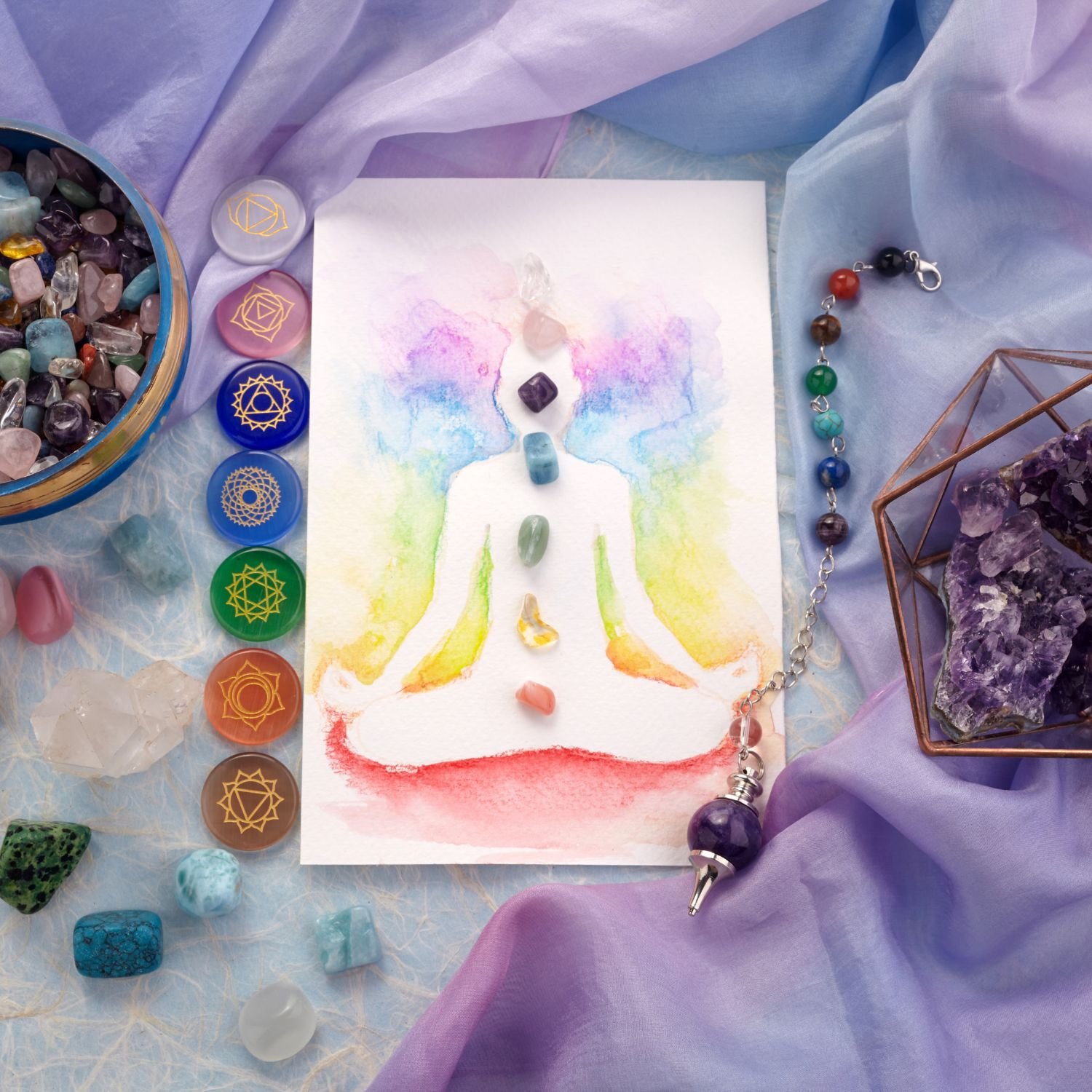What's the link between the 7 Chakras and Gem Therapy?
Each chakra is associated with a specific color, location in the body, and function. The chakras are believed to be connected to each other and work together to keep the body in harmony. The chakras are said to influence both physical and emotional well-being, and when they are balanced, a person is said to feel healthy and content. When one or more chakras is blocked, imbalance can occur, leading to physical and emotional symptoms. In gem therapy, different gemstones are said to have the power to balance the energy in different chakras and promote healing.
The chakra system is an ancient belief system in Hindu and yoga tradition that there are seven energy centers in the body, known as chakras. The chakras are believed to be seven spinning wheels of energy that run along the length of the spine, from the base of the spine to the crown of the head. Each chakra is associated with a specific color, location in the body, and function.
The chakras are believed to be connected to each other and work together to keep the body in harmony. The chakras are said to influence both physical and emotional well-being, and when they are balanced, a person is said to feel healthy and content. When one or more chakras is blocked, imbalance can occur, leading to physical and emotional symptoms.
In gem therapy, different gemstones are said to have the power to balance the energy in different chakras and promote healing.
The seven chakras and their associated characteristics are:
Muladhara (Root Chakra)
Located at the base of the spine, this chakra is associated with the color red and governs the basic needs for survival, grounding and security. When the root chakra is balanced, one feels confident and secure in their daily life. An imbalanced root chakra is linked to anxiety, insecurity, lack of stability and feelings of disconnectedness. Gemstones such as garnet, black tourmaline, smoky quartz, and red jasper are used to strengthen and balance the root chakra in gem therapy. These gemstones are believed to be grounding and provide a strong sense of stability. They are said to be helpful for issues such as anxiety, depression, and fatigue.
Svadhisthana (Sacral Chakra)
Located just below the navel, this chakra is associated with the color orange and governs emotions, sexuality and creativity. When the sacral chakra is balanced, one is said to feel confident, sexually fulfilled and able to express their emotions in a positive way. An imbalanced sacral chakra may involve guilt, shame, addiction or sexual dysfunction. Gemstones like carnelian, orange calcite, orange agate, and moonstone are used to balance the energy of the sacral chakra. These gemstones are believed to promote sexuality and emotional well-being. They are said to be helpful for issues such as emotional imbalance, infertility, and impotence.
Manipura (Solar Plexus Chakra)
Located at the solar plexus, this chakra is associated with the color yellow and governs personal power, self-esteem, and metabolism. When balanced, the solar plexus chakra allows a person to feel empowered, self-assured and in control of their life. An imbalanced solar plexus chakra is associated with low self-esteem, powerlessness and anger. Gemstones used to balance the solar plexus chakra are citrine, tiger's eye, yellow jasper, and golden topaz. These gemstones are believed to be energizing and help to promote personal power and self-worth. They are said to be helpful for issues such as anxiety, depression, and fatigue.
Anahata (Heart Chakra)
Located at the heart, this chakra is associated with the color green and governs love, compassion and balance. When balanced, the heart chakra allows a person to feel love, empathy and understanding for others. An imbalanced heart chakra is associated with anxiety, depression and difficulty in relationships. Gemstones such as rose quartz, aventurine, jade, and malachite are used to harmonize the heart chakra in gem therapy. These gemstones are believed to be soothing and promote love, compassion, and emotional well-being. They are said to be helpful for issues such as heart problems, high blood pressure, and emotional imbalances.
Vishuddha (Throat Chakra)
Located at the throat, this chakra is associated with the color blue and governs communication and self-expression. When throat chakra is balanced, it allows a person to express themselves clearly and effectively and connect with others easily. An imbalanced throat chakra is linked to communication difficulties, shyness and dishonesty. Gemstones like Blue lace agate, aquamarine, blue topaz, and turquoise are used to soothe and heal the throat chakra. These gemstones are believed to promote self-expression, communication, and spiritual growth. They are said to be helpful for issues such as headaches, eye problems, and sore throat.
Ajna (Third Eye Chakra)
Located between the eyebrows, this chakra is associated with the color indigo and governs intuition and spiritual insight. A balanced third eye chakra allows a person to trust their intuition and have a deeper understanding of the world around them. An imbalanced third eye chakra is associated with lack of intuition, confusion and lack of imagination and creativity. Gemstones such as amethyst, lapis lazuli, sodalite, and purple fluorite are used to awaken the third eye chakra. These gemstones are believed to promote spiritual insight and intuition. They are said to be helpful for issues such as headaches, eye problems, and emotional imbalances.
Sahasrara (Crown Chakra)
Located at the crown of the head, this chakra is associated with the color violet and governs spiritual connection and enlightenment. People who have a balanced crown chakra are said to be more connected to the divine, more spiritual and more aware of their connection to the universe. An imbalanced crown chakra is linked with a lack of purpose, depression and mental fatigue. Clear quartz, diamond, selenite, and white sapphire are used to clear blockages in the crown chakra. These gemstones are believed to promote spiritual growth and clarity. They are said to be helpful for issues such as headaches, eye problems, and emotional imbalances.
It's important to note that these traditional beliefs about gemstones have not been scientifically proven, and gemstone therapy should not be used as a substitute for conventional medical treatment. It's always important to consult with a qualified practitioner before using gemstones as a form of treatment and also to consult with a doctor or healthcare professional before use.
Dive deeper into the world of jewelry
Be sure to visit the blog. Get fascinating insights straight from experts around the world and pick up secret tips to make jewelry shopping a breeze.




From ancient civilizations to modern times, gemstones have been believed to have a powerful and transformative effect on the body, mind, and spirit. If you are inspired to incorporate gem therapy into your daily routine, check out this list of 30 of the most popular gemstones and their perceived benefits. Whether you're seeking calmness, creativity, or grounding, there's a gemstone for you!